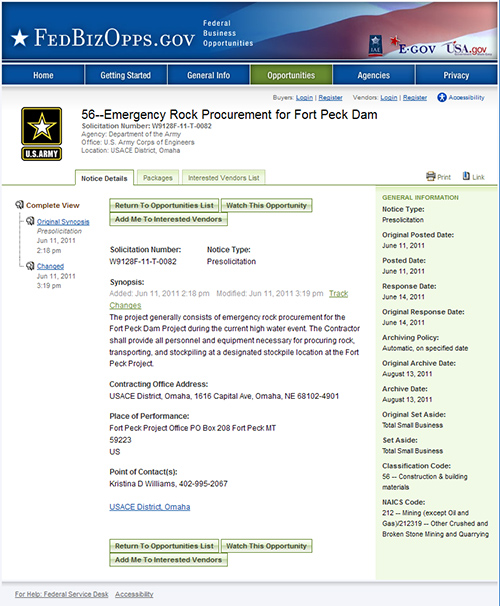
While I won’t join the cacophony of detractors claiming that the Army Corps of Engineers should have possessed some sort of “crystal ball” to foresee the weather conditions which have brought us to this point, I do think they need a remedial lesson in being forthcoming. I have a hard time believing that they didn’t know that a 55kcfs release rate would not eventually have to be throttled up to the 150kcfs rate. Burleigh County Commissioner Mark Armstrong has been trying to wring details out of them without result, leading to distrust and wild theory.
One of the theories making the rounds out there is the one I just linked above using Scribd: It’s a man who has spent plenty of time around the Missouri River system and claims that Fort Peck Dam is like a “first domino” (those words are mine) in a potentially greater failure which could cut a deep swath through a good portion of the Midwest.

Then you get the photo posted above on the Corps’ own Flickr feed. It shows one of their people pounding in a warning sign and fence near Fort Peck while the bank crumbles into the lake behind them. That’s reassuring, isn’t it?
Granted, the Shanks fella who I referred to a couple of paragraphs back has two strikes against him: first, he works for an environmentalist advocacy group; and second, he has an upcoming book release on this very subject. What better way to drum up interest? He does, however, raise some interesting questions.

Then, of course, you have to wonder about this: an emergency bid being put out for the material which reinforces the Fort Peck Dam, the very one Mr. Shanks claims is the weak link and which is already at 111% of its flood control capacity.
These would likely be defused as a “smoking gun” if the Corps would simply be a little more forthcoming. I know there are some answers which nobody can have on hand, but I find myself sitting here wondering when the 175kcfs shoe is gonna drop. If it does, we’ve got some serious issues to deal with.
The local dikes are built with the mantra “twenty point six plus one” in mind. Suppose the Corps chooses to, or is forced to, increase releases past the 150kcfs mark? Could we build all of those levees even higher still, even if we wanted to? And that leads me back to my original question: why did our local officials even take them at their word in regard to the 150kcfs number, after they’ve constantly moved the goal posts on us?
While Garrison is down a bit, Fort Peck’s inflows are 150% of their outflows…and again, that reservoir is at 111% of Flood Control storage capacity without the spring runoff even starting yet. If the Corps has a plan for this mess, I think they need to be forthcoming with answers to people’s concerns. I still think that anyone who relies on the Corps’ current numbers to have any finality is fooling themselves.
I’m not trying to feed the rumor mill here, so don’t take this post the wrong way. What I am saying is that there are a lot of really inconvenient tidbits of partial information floating around out there, and they can really be used to feed the hysteria if treated improperly or if people are left to try to find their own information and let their imaginations wander.
And if you haven’t already thrown the kids and the photo albums in the car and fled screaming for the hills, you may wish to read this recently posted response by the man in charge of the Omaha District of the Army Corps of Engineers, posted on the Bismarck city website.
Despite that recent assurance, I think the Army Corps of Engineers needs to be more forthcoming while attempting to reassure people that they do have a plan in detail. As far as the people who have decided that Bismarck and Mandan are building to the “twenty point six plus one” is the end of our dike-building, I wish only to remind them how quickly 55,000cfs turned into 150,000cfs…only a matter of days. They need to try to keep the Corps accountable, and if further planning and preparation are needed this is the time to make sure that they happen.
